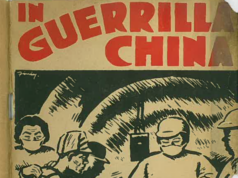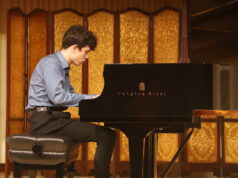Whenever one mentions the Silk Road, images are conjured up of caravans travelling across the central Asian plains carrying silk and other goods from the faraway East and many fascinating books have been written about this trading highway, not least by Marco Polo.
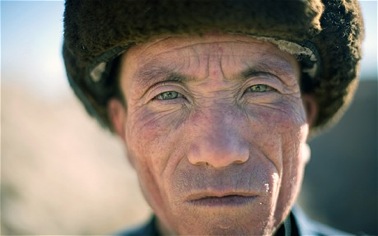
In recent years, another fascinating story has come to light in Yongchang County, in Gansu Province. The ancient North Silk Road passes through the county and it had been noted that many of the villagers of Liqian village have pale skins, green eyes and European features. Tests were said to have found that the DNA of some of the inhabitants was 56 per cent Caucasian in origin. One villager, Cai Junnian, is nicknamed Cai Luoma (the Roman) because he is green-eyed and light skinned.
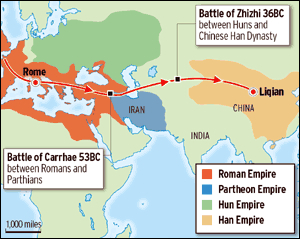
Note the incorrect spelling of ‘Parthian Empire’
This reiterated a theory by historian Homer H. Dubs in 1941 that Roman soldiers, who had been captured by the Chinese, founded Liqian (possibly from ‘legion’). Also, in a geography book of the eastern Han Dynasty, it was recorded that “local people call the ancestors of the Roman prisoners-of-war ‘Lijian’, this being the Chinese name for something or someone of Greco-Roman origin. Dubs speculated that after losing the battle of Carrhae (north of Syria) in 54 BC, an estimated 10,000 Roman prisoners were sent to Margiana (now Turkmenistan) to man the frontier. Later the nomadic Xiongnu chief, Zhizhi, established a state further east near modern day Taraz (in Kazakhstan). Dubs states that a Chinese account describes ‘about 100 men’ fought to defend Zhizhi’s wooden-palisade fortress against Han forces in the Battle of Zhizhi in 36BC. Chinese chroniclers refer to the capture of a “fish-scale formation” of troops, a possible reference to the “tortoise” phalanx formation perfected by legionaries.
Archaeologists planned to conduct digs in the region, along the ancient Silk Route, to search for remains of forts or other structures built by the fabled army.
“We hope to prove the legend by digging and discovering more evidence of China’s early contacts with the Roman Empire,” Yuan Honggeng, the head of a newly-established Italian Studies Centre at Lanzhou University in Gansu province, told the China Daily newspaper a few years ago.
There are, however, conflicting views on this and DNA tests conducted in early 2007, in an attempt to find the genetic evidence supporting this claim, showed a negative result. That study concluded: – ‘Overall, a Roman mercenary origin could not be accepted as true according to paternal genetic variation and the current Liqian population is more likely to be a subgroup of the Chinese majority, Han’.
Maurizio Bettini, a classicist and anthropologist from Siena University, has dismissed the theory as “a fairy tale”. “For it to be indisputable, one would need to find items such as Roman money or weapons that were typical of Roman legionaries,” he told the Italian newspaper La Republica. “Without proof of this kind, the story of the lost legions is just a legend.”
So it seems that opinions are still divided on this mystery.
However, for all the romance of the story, it might well be true. People don’t move very much unless they’re forced to by war, famine or natural disaster. That’s why there are still a lot of people called Evans in Wales, and McDonald in Scotland; they’ve stayed near the spot where their surnames first emerged half a millennium or more ago.
The Romans left behind their DNA in Britain. The same goes for other civilisations; green and blue-eyed Afghans claim descent from Alexander the Great’s troops, who got as far as India in the 4th century BC, so there is no reason to disbelieve them, either.
From a more personal point of view about the subject and closer to home, two members of NZCFS visited Yongchang in 2011. Deborah Rhode, vice president of Christchurch Branch, and Dave Bromwich, now NZCFS president and treasurer of Hawkes Bay branch, were in Gansu and Shaanxi monitoring and evaluating NZCFS co-operative health projects, and also visiting the Shandan Baille school.
They spent 3 days in Yangchang but came away with more questions than answers!
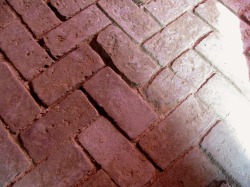
Deborah continues: “We visited the ‘new’ reconstruction of the old city, and also the village itself where the farmers in the photographs actually lived. Not many people were around during the day, but there was one elderly woman who was being visited by her son. As Dave speaks Chinese we were able to visit with them and they invited us into her house. It was very modest. But what caught my eye was the very attractive brick floor in a herringbone pattern. I don’t know why this caught my eye…. but it was enough for me to Google it. I discovered it had been a popular pattern in Roman times!! (and perhaps first designed by them) – more for the ancient Roman theory I thought! I have of course since noticed it in many places in China….. but….. how did it get there?!!
“The Museum was quite new, and actually very well curated. It gave a very compelling argument for the Roman legion theory. At the time I was quite prepared to believe it all. (It’s only in retrospect that I have become somewhat more sceptical).
Whether the legend is true or not, I think what’s being made of it is fascinating!”
She continues, “At first I was totally believing of the story researched by a respected American academic that the area might have been settled by remnants of a Roman Legion.
But on reflection and seeing the incredible amount of money, time and effort that is being poured into the area to ‘recreate’ the town, to make the idea real, I am more sceptical that it is perhaps a wonderful idea for a tourism promotion. I have since heard that almost a complete town has been created! And that area of China doesn’t have many big tourist attractions…..

“On travelling around China, I have seen so many Chinese people with significantly western features, and of course the Gansu corridor was, throughout history, travelled by people of all origins, so many half-Chinese babies would have been expected.
I think it’s a great story – and I still kind of want to believe it! But in the museum, it was all photographic and conjectural – what was missing were material artefacts. And that seems strange from a ‘Roman’ town.
I don’t know enough Chinese to know about any linguistic remnants – I don’t think it was mentioned in anything I read.
“I still think it’s worth a visit, and I think it makes an interesting story. From an anthropological point of view – even if the story isn’t true in itself – it’s fascinating what has been done with it and how it’s fast “becoming real”!! After all – history is always created by man’s interpretation.”

And finally, on a very amusing note, Deborah says, “We did notice how many women (and some young men) did indeed have either reddish hair or red tints. When we found one young woman who seemed very comfortable chatting with us (at the museum I think) – Dave commented on this. She said – “Oh yes, we often colour our hair because we prefer it to plain black”!
But Dave also remembers that she said only 60% dyed their hair, while 40% were naturally red-haired! So the jury is still out on the case.
– Teri France
Related Articles
- Harry Mount: Roman blood runs through Chinese – and British – veins Telegraph newspaper blog, 25 Nov 2010
- Have the descendants of Rome’s lost legion been found in China? Article on Telegraph newspaper website, 02 Feb 2007
For the Quora web-article on the same topic, click HERE. The comments after the article are also worth reading.


